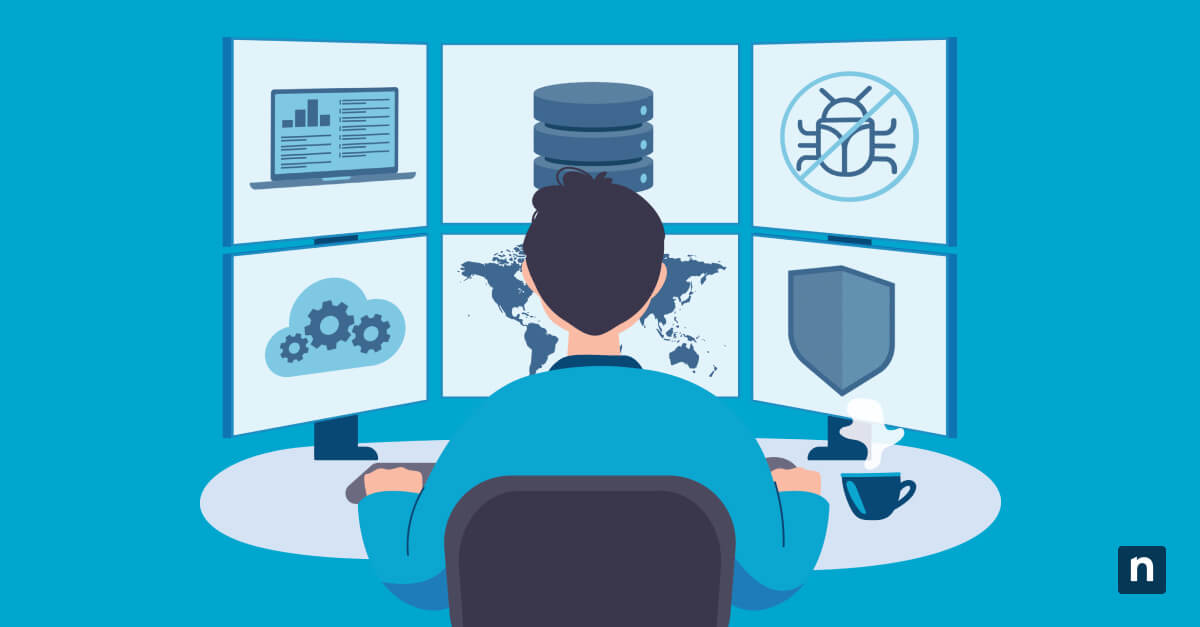Patch caching is a beneficial strategy for MSPs’ and IT professionals’ clients. It allows patch files for software updates to be stored locally instead of downloaded from the internet individually per client device. However, it’s an IT jargon that non-technical stakeholders won’t always understand. To help them see its business benefits, you must explain the concept well and communicate its role in boosting productivity and reducing costs.
How to explain patch caching to non-tech stakeholders
Many decision-makers in organizations think that MSP patching is just another background task, so they may not see how caching patches can help their businesses. The most crucial part of explaining it to them is shifting the conversation from technical mechanics to business impact. Here are some methods to do this:
📌 Prerequisites:
- Basic understanding of key patch management concepts (such as RTO/RPO, deployment cadence, compliance drivers)
- Awareness of local caching technologies (for example, Windows Delivery Optimization, proxy caching servers)
- Ability to present technical details using analogies and metrics meaningful to leadership
- Access to available patch success and failure reports to demonstrate outcomes
Method 1: Define patch caching in everyday terms
Non-tech stakeholders can grasp technical concepts much faster if you explain them in layperson’s terms.
Use relatable analogies
Comparing industry-specific terms with more relatable everyday things simplifies IT subjects for almost everyone who needs to hear about them.
- A library: “Think of patch caching like it’s a library. Instead of every employee buying the same book, the library buys one copy and everyone borrows it when needed.”
- Office coffee: “It’s like having a coffee machine in the office. Instead of individually buying a cup outside, everyone can just make their own inside the office.”
Emphasize simplicity
Avoid words like “repository,” “network load,” or “multicast.” Instead, use phrases like “shared copy” or “avoiding repeat work.”
Method 2: Highlight business benefits over technical details
It’s best to focus on concrete business outcomes rather than specifics because decision-makers care about cost savings, productivity, and risk reduction, not bandwidth graphs or network architecture.
Emphasize key business benefits, such as:
- Cost savings:
- Reduced internet service costs
- Minimized overage charges on metered connections
- Highlighted savings for monthly or annual bandwidth reductions
- Efficiency and productivity:
- Devices update faster
- Faster updates = less waiting time and disruptions
- Less time troubleshooting patch delays or re-running failed deployments
- Reliability and resilience:
- Updates are available even if internet connections are slow or unstable
- Updated endpoints across all locations, including branch offices with weaker links
- Compliance and security:
- Timely patching as required by regulatory frameworks (such as HIPAA, CJIS, NIS2)
- Reduced network bottlenecks → patch compliance → reduced exposure to vulnerabilities
- Reduced risk of fines or reputational damage
Method 3: Show the risk of not using patch caching
Stakeholders may not fully appreciate the benefits of this strategy, so it may help if you present them with the potential consequences of not implementing it, especially when tied to cost, productivity, and compliance.
Some risks of not having caching include:
| Risk | Potential Consequences |
| Bandwidth waste |
|
| Slow patch cycles |
|
| Network disruptions |
|
| Compliance gaps |
|
Frame the mentioned risks by:
- Using business terms (like, downtime, lost productivity, compliance exposure, financial penalties), not technical jargon
- Positioning patch caching as a preventive strategy or a small investment that avoids larger costs later
- Pair risks with real or estimated impact (for example, “Without caching, patch days slowed the network for 3 hours, impacting 200 employees”).
Method 4: Provide simple metrics and reports
Although you want to simplify explanations, you still need numbers to support your words. To make raw logs and technical dashboards easier to understand, provide clear, visual metrics that show how patch caching translates into real-world impact.
First, track the following metrics:
- Bandwidth savings: Show how much data was avoided by downloading patches once instead of multiple times.
- Example metric: “120 GB of bandwidth saved this month.”
- Time to deploy patches: Track average patch installation times before vs. after caching.
- Example metric: “Deployment time reduced from 3 days to under 1 day.”
- Endpoint compliance: Measure the percentage of devices patched within required SLAs.
- Example metric: “95% of endpoints patched within 48 hours.”
- Success vs. failure rates: Highlight improvements in patch reliability with caching in place.
- Example metric: “Failure rate dropped from 12% to 3%.”
Consider presenting the data as:
- Visual indicators: Tables with red/yellow/green (RAG) status indicators (for example, bandwidth savings = green, patch SLA compliance = yellow)
- Trend charts: Line or bar graphs that show improvement over time
- Side-by-side comparisons: Before-and-after metrics to show the impact
- Executive summaries: Reports with 1-2 slides or a half-page summary with 3-4 key insights
Method 5: Position patch caching as a compliance enabler
Patching is part of compliance, especially in regulated industries like healthcare, finance, and government. Regulatory frameworks like HIPAA, CJIS, PCI-DSS, and NIS2 demand timely updates to protect sensitive data and maintain operational integrity. Patch caching directly supports these obligations by removing bottlenecks that slow deployments.
Make sure to emphasize the following key points:
- Faster patching = reduced risk: Cached updates allow IT to patch all devices quickly, limiting vulnerability exposure.
- Meeting SLAs: Many compliance standards expect patches within defined timeframes (24-72 hours), and caching ensures IT can consistently meet those deadlines.
- Audit evidence: Reports on patch speed, coverage, and success rates can be documented as part of audit readiness.
- Strategic framing: Instead of framing patch caching as “an IT optimization,” present it as “a tool that keeps the organization compliant, secure, and audit-ready.”
Best practices summary table
Explaining this technical concept works best when using all the strategies mentioned before. Here’s a quick summary of these best practices:
| Practice | Value to stakeholders |
| Use analogies | Makes caching relatable and easy to understand |
| Highlight business outcomes | Focuses on cost savings, speed, and reliability |
| Present risks without caching | Frames consequences in real-world terms (downtime, lost productivity) |
| Show metrics visually | Builds trust through transparency and clarity |
| Tie to compliance | Reinforces strategic importance and audit readiness |
What is caching, and how does it work?
Caching temporarily stores data in a specific location for faster access the next time a user needs it. The process of caching involves:
- A user or device requests a piece of data (like a web page, software patch, or file) from the original source (for the first time).
- The fetched data is stored locally in a cache (such as on the user’s device, a server, or a network appliance).
- When another request for the same data comes in, the system checks the cache first and delivers it instantly if it finds a valid copy.
- Cached data has a “time-to-live” (TTL) or expiration policy, so once expired, the system re-fetches the data from the source to keep it fresh and accurate.
In IT management, caching patches is the act of downloading updates once to a local server or device and then sharing them with multiple endpoints.
Why clear communication about this strategy matters
Patch caching offers many benefits to the clients of MSP and IT teams, such as the following:
- Reduced bandwidth usage: Patches are downloaded only once and shared across devices, which helps lower internet costs and minimizes congestion.
- Faster deployments: Endpoints quickly receive updates, reducing downtime and improving employee productivity.
- Reliability and resilience: Even with an unstable internet, cached patch deployment ensures machines still get necessary updates.
- Improved compliance: Organizations can more easily meet patch SLAs and regulatory requirements by avoiding delays in patch delivery.
When MSPs and IT teams communicate this concept and its many benefits well to non-technical stakeholders, it can:
- Secure leadership buy-in by allowing stakeholders to see how technical investments directly support cost control, speed, and uptime.
- Strengthen credibility through transparency around how tech teams reduce risks and save resources.
- Justifies infrastructure decisions for enabling tools like Delivery Optimization or caching servers because the benefits are clear.
- Show that patch caching is not just “IT housekeeping,” but a driver of productivity, compliance, and financial savings.
Automation touchpoint example
Automation can make patch caching more appealing to non-technical stakeholders without adding more work for IT teams.
You can automate the following:
- Patch success and failure reports: Automatically generate summaries of how many devices successfully received patches, highlighting improvements compared to pre-caching performance.
- Bandwidth usage reports: Track how much network load has been reduced through caching, then present the data in business terms (for example, X GB saved per month = smoother operations and lower costs).
- Compliance metrics: Show the percentage of endpoints patched within required SLAs and automate red/yellow/green status indicators so leadership can see at a glance if patching goals are being met.
After data collection, deliver the numbers through:
- Executive summaries with visual charts or graphs to make trends clear
- Automated reports delivered monthly or quarterly to align with business reviews
- Quarterly business reviews (QBRs) that translate numbers into business impact (for example, “We saved 35% in bandwidth this quarter.” or “98% of endpoints were patched within SLA, improving audit readiness.”)
NinjaOne integration
NinjaOne has many capabilities that can help MSPs clearly demonstrate the value of patch caching to stakeholders.
| Capability | How it supports stakeholder communication |
| Automated patch reports | Generate success and failure summaries without manual effort, proving patching reliability. |
| Compliance tracking | Monitor patch compliance against SLA targets and highlight results in business terms. |
| Bandwidth and time-to-patch metrics | Provide lightweight dashboards showing saved bandwidth and reduced deployment times. |
| Documentation hub | Store briefing notes, patching policies, or stakeholder-facing documents in NinjaOne Docs for easy access. |
| QBR integration | Pull patch metrics directly into client-facing quarterly business review (QBR) presentations, reinforcing ongoing value. |
Turning a technical process into business value
Although patch caching is a technical strategy, it should also concern non-technical stakeholders who hold decision-making power within organizations. Properly communicating the concept and its many business benefits will help them more easily understand the strategy and see its investment value for business growth.
Related topics:








